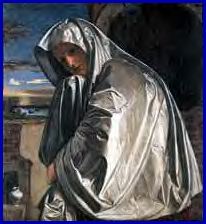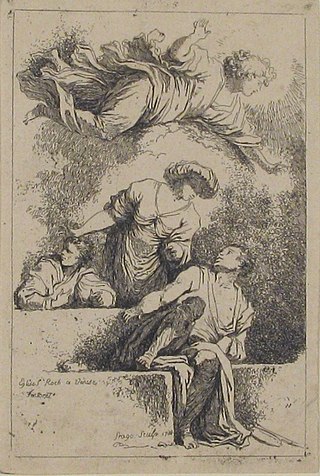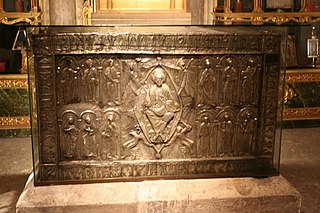
Mark 16 is the final chapter of the Gospel of Mark in the New Testament of the Christian Bible. Christopher Tuckett refers to it as a "sequel to the story of Jesus' death and burial". The chapter begins after the sabbath has ended, with Mary Magdalene, Mary the mother of James, and Salome purchasing spices to bring to the tomb next morning to anoint Jesus' body. There they encounter the stone rolled away, the tomb open, and a young man dressed in white who announces the resurrection of Jesus. The two oldest manuscripts of Mark 16 conclude with verse 8, which ends with the women fleeing from the empty tomb, and saying "nothing to anyone, because they were too frightened".

John 20:17 is the 17th verse of the twentieth chapter of the Gospel of John in the New Testament. It contains Jesus' response to Mary Magdalene just after he meets her outside his tomb after his resurrection. According to the longer ending of Mark's Gospel Mary Magdalene is the first person to whom Jesus shows himself alive after his resurrection.

John 20:15 is the 15th verse of the twentieth chapter of the Gospel of John in the New Testament of the Christian Bible. Mary Magdalene has returned to Jesus' tomb and found it empty. She does not know that Jesus has risen from death and they begin conversing without her realizing his identity.
John 20 is the twentieth chapter of the Gospel of John in the New Testament. It relates the story of Jesus' resurrection. It relates how Mary Magdalene went to the tomb of Jesus and found it empty. Jesus appears to her and speaks of his resurrection and dispatches Mary to tell the news to the disciples. Jesus then appears to his disciples. The events related in John 20 are described somewhat differently in Matthew 28, Mark 16, and Luke 24.

John 20:18 is the eighteenth verse of the twentieth chapter of the Gospel of John in the New Testament. It occurs after Jesus' resurrection and appearance to Mary Magdalene. In the previous verse Jesus has given Mary a message to deliver to his disciples, this verse describes how she delivers it.

John 20:14 is the fourteenth verse of the twentieth chapter of the Gospel of John in the New Testament of the Christian Bible. In this verse, Mary Magdalene has just finished speaking to the angels she found in Jesus's empty tomb. She then turns and sees the resurrected Jesus, but fails to recognize him. In the Gospel of John, this is the first moment anyone sees Jesus after his resurrection.

John 20:12 is the twelfth verse of the twentieth chapter of the Gospel of John in the New Testament of the Christian Bible. Mary Magdalene is peering into the empty tomb of Jesus and sees two angels.

John 20:11 is the eleventh verse of the twentieth chapter of the Gospel of John in the New Testament of the Christian Bible.

John 20:10 is the tenth verse of the twentieth chapter of the Gospel of John. Peter and the Beloved Disciple have just finished examining the empty tomb of Jesus, and in this verse they return home.

John 20:9 is the ninth verse of the twentieth chapter of the Gospel of John in the Bible. Peter and the Beloved Disciple have been examining Jesus' empty tomb and the arrangement of the grave clothes. John 20:8 states that the Beloved Disciple looked in the tomb and believed, though there is conflict on what exactly he believed. John 20:9 seems to modify this statement but its exact meaning is also unclear.

John 20:7 is the seventh verse of the twentieth chapter of the Gospel of John in the Bible. In this verse, Peter is standing in Jesus' empty tomb. The Beloved Disciple and perhaps Mary Magdalene are outside. This verse describes the arrangement of the grave clothes they see.

John 20:16 is the sixteenth verse in the twentieth chapter of the Gospel of John in the New Testament of the Bible. The verse describes the moment that Mary Magdalene realizes that Jesus has returned from the dead, when she recognizes his voice calling her name.

John 20:6 is the sixth verse of the twentieth chapter of the Gospel of John in the Bible. Peter and the Beloved Disciple have just arrived at the empty tomb of Jesus. The Beloved Disciple, who arrived slightly ahead of Peter, paused outside the empty tomb. In the verse, Peter enters the tomb upon his arrival.

John 20:5 is the fifth verse of the twentieth chapter of the Gospel of John in the Bible. The Beloved Disciple and Peter have travelled to the tomb of Jesus to investigate Mary Magdalene's report that the body of Jesus had disappeared. In this verse the Beloved Disciple arrives at the tomb and while he looks in, he does not enter it.

John 20:2 is the second verse of the twentieth chapter of the Gospel of John in the New Testament. Mary Magdalene has just discovered that the tomb of Jesus has been opened. In this verse she seeks out and tells this news to Peter and the "disciple whom Jesus loved".

John 20:3–4 are the third and fourth verses of the twentieth chapter of the Gospel of John in the New Testament. Peter and the Beloved Disciple have been informed by Mary Magdalene that Jesus' tomb has been opened and in these verses they depart for the tomb.

John 20:1 is the first verse of the twentieth chapter of the Gospel of John in the New Testament. John 20 covers the resurrection of Jesus after his crucifixion. In this verse Mary Magdalene visits Jesus' tomb and finds it opened.

Matthew 28 is the twenty-eighth and final chapter of the Gospel of Matthew in the New Testament. This chapter records that Jesus is risen, describes the actions of the first witnesses to this event, and ends with the Great Commission.

Matthew 28:10 is the tenth verse of the twenty-eighth chapter in the Gospel of Matthew in the New Testament. This verse is part of the resurrection narrative. Having left the empty tomb, Mary Magdalene and "the other Mary" are on their way to meet the other disciples, when Jesus meets with them. In this verse the risen Jesus speaks with them.

In Eastern Orthodox Christian tradition the Myrrhbearers are the individuals mentioned in the New Testament who were directly involved in the burial or who discovered the empty tomb following the resurrection of Jesus. The term traditionally refers to the women who came with myrrh to the tomb of Christ early in the morning to find it empty. Also included are Joseph of Arimathea and Nicodemus, who took the body of Jesus down from the cross, anointed it with myrrh and aloes, wrapped it in clean linen, and placed it in a new tomb. In Western Christianity, the women at the tomb, the Three Marys or other variants are the terms normally used.



















